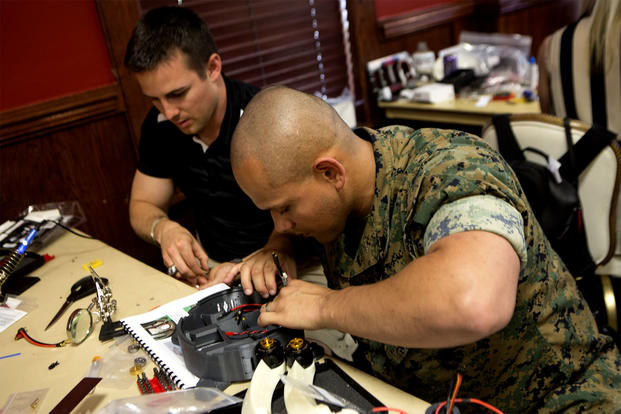With reports of ISIS drones attacking U.S. troops and surveilling coalition positions on the rise, a Marine Corps unit decided to assemble its own task force to fight the problem.
Special Purpose Marine Air-Ground Task Force Crisis Response-Central Command, a unit of roughly 2,200 troops that deploys in seven-month rotations to various locations in the Middle East, set up a counter-unmanned aerial systems working group ahead of its most recent deployment.
The move, a first for the service, enabled the task force to assess different methods of fighting the enemy drone threat and to develop conclusions about how to best defend its own positions.
Col. William Vivian, who returned in August after a tour commanding the task force downrange, said the unit saw an opportunity to make the most of its deployment.
"The Marines were coming back from deployment saying, 'We're seeing quadcopters and things like that flown over our positions,' " he said. "So we started to inject that into our training. Back in [the continental U.S.], it's really challenging to get that stuff injected into your training, and there's not a lot a regiment can do on its own to defeat that threat.
"So we really worked on mitigating it and practicing good procedures, reducing our signature and things of that nature so we'd be less vulnerable to it," he said.
The working group was organized at the start of 2016, with a "nucleus" of four or five Marines, though at any given time up to 25 troops were contributing to its counter-drone efforts, Vivian said.
"When we deployed, we stepped it up a notch," he said. "Because we were in so many locations across the theater and there were so many approaches being taken by the joint force, we were exposed to almost all of them. So we tried to bring that together and kind of harness that, build that knowledge for our Marines."
The task force operates out of a half-dozen countries within the Middle East. In addition to supporting the fight against ISIS with airstrikes, a security presence in Iraq, and small advise-and-assist teams, the unit participates in a number of theater security cooperation exercises with other nations and trains for aircraft recovery missions and embassy security reinforcement.
While the Marines weren't in a position to field-test new counter-drone technologies, they were able to observe and contrast measures and systems being used by a range of U.S. forces in the region, Vivian said.
"What the [special operations] guys were using is not necessarily what the Army is using, and it's not what we had in our Marine task forces," Vivian said. "And then what grew out of that was, 'Hey, how can we contribute to defeats and what can we do to prepare our Marines?' "
The emerging field of counter-drone technology runs the gamut from devices such as Battelle's DroneDefender, which can take aim at a UAS and drop it from the sky, to technologies that purport to create a defensive perimeter that blocks drones using radio frequencies.
To date, the Marine Corps has tested both, although service leaders have not publicly announced a way forward in drone defense. During the recent deployment, the Marines' Middle East task force also organized a "Ripper Lab," a 3D printing operation that, among other things, made roughly 25 versions of a small quadcopter called "The Nibbler".
This, too, aided the Marines' efforts to defend against enemy unmanned systems, Vivian said. "Really, it built the understanding of how these things are put together," he said.
"They can be locally manufactured; we know that ISIS is doing that. And then how can it be used -- we know the strengths and weaknesses, limitations, so the Marines can better understand the threats that can be used against them."
While Vivian said he couldn't speak to specifics, he believes the Marines made progress on solving the problem.
Recommendations for how to improve the Corps' drone defenses are within a classified after-action report submitted to Marine leadership following the deployment.
"We were definitely trying to solve a practical problem, which is what was different from here at Headquarters Marine Corps," Vivian said. "They don't have tactical problems staring them in the face the way we did, so that was kind of the thing that was motivating us."
Vivian said the unit shared what it had learned with the command element of the rotation that replaced it in-theater, so Marines could continue to work the problem on the ground level.
-- Hope Hodge Seck can be reached at hope.seck@military.com. Follow her on Twitter at @HopeSeck.






























